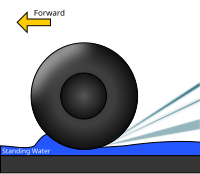
Photo from wikipedia
Abstract In a centrifuged model, the centrifugal acceleration increases radially outward from the axis of rotation. The variations in the magnitude and direction of the centrifugal acceleration will inevitably result… Click to show full abstract
Abstract In a centrifuged model, the centrifugal acceleration increases radially outward from the axis of rotation. The variations in the magnitude and direction of the centrifugal acceleration will inevitably result in a distortion of the stress field of the model compared with its desired prototype counterpart. This distortion alone is generally considered to be slight and negligible, but the extent of its impact on the accuracy of the centrifuge modeling of the soil slope instability is yet unknown. To answer this question, analytical solutions for a generally shaped critical slip surface and its normal stress distribution are derived for a plane-strain model slope by using a variational limiting equilibrium approach, without a need for arbitrary kinematic and static assumptions. Their validities are verified by comparing the extreme cases of the proposed solutions with available analytical solutions for the slope instability under the Earth's gravity condition. The proposed solutions are also validated by a well-documented centrifuge study of the slope instability with slip surface measurements, and reasonably good agreement is obtained. A parametric study is carried out by using the proposed solutions. The computed results for the model slopes are compared with those for the corresponding prototype slopes. The comparison shows that when the cross section of the model slope is radially oriented to the axis of rotation, the variation in the magnitude of the centrifugal acceleration alone has a negligible influence on the slope instability. When the cross section of the model slope is tangentially oriented to the circumference of the rotation of the centrifuge, however, the radial acceleration is shown to have a potentially important influence on the similitude of the slope instability. An optimum location of a model slope in a model container for the minimal effect of the radial acceleration can be determined by using the proposed solutions.
Journal Title: Engineering Geology
Year Published: 2020
Link to full text (if available)
Share on Social Media: Sign Up to like & get
recommendations!